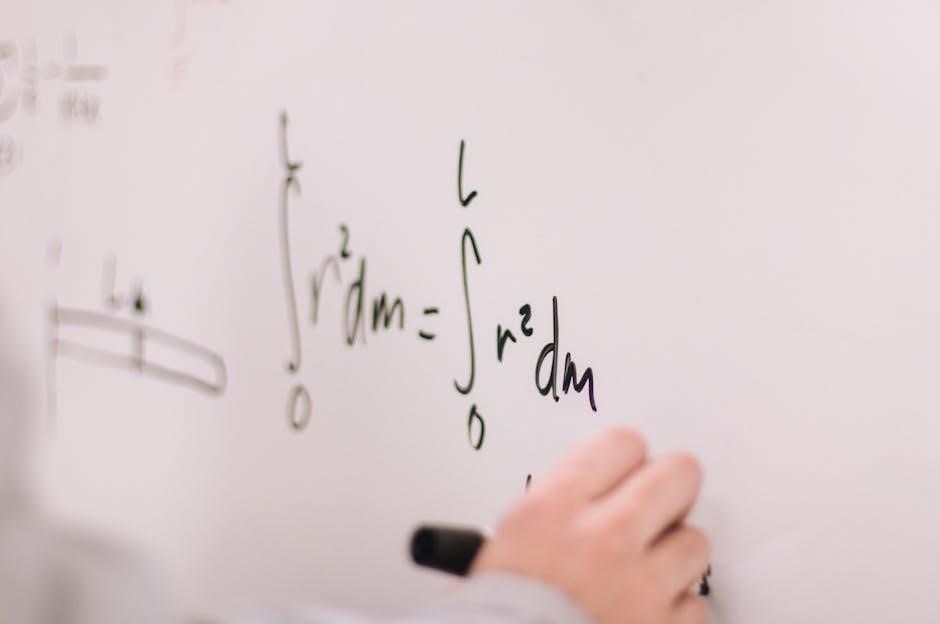Systems of equations involve two or more equations with the same variables. They are fundamental in algebra, allowing the solution of multiple unknowns. These equations model real-world problems, such as budgeting or physics, requiring methods like substitution, elimination, or graphing to find variable values.
What Are Systems of Equations?
Systems of equations are sets of two or more equations with the same variables. They are used to model real-world problems, such as budgeting, physics, and engineering. Solving these systems provides values for the variables that satisfy all equations simultaneously.
These systems can be solved using methods like substitution, elimination, or graphing. They are essential in algebra and applied mathematics, offering practical solutions to complex scenarios. Worksheets, including PDF resources, often include practice problems to master these concepts effectively.
Importance of Learning Systems of Equations
Learning systems of equations is crucial for developing problem-solving skills in algebra and real-world applications. It enhances critical thinking and analytical abilities, essential for fields like physics, engineering, and economics. Mastering these concepts allows students to model and solve complex scenarios, such as optimizing resources or predicting outcomes. Worksheets, including PDF resources, provide structured practice, helping learners build confidence and proficiency in solving systems of equations effectively.

Methods for Solving Systems of Equations
Common methods include graphing, substitution, and elimination. Graphing visually identifies solutions, while substitution and elimination algebraically find variable values, each offering unique problem-solving approaches.
Graphing Method
The graphing method involves plotting each equation on a coordinate plane. The solution is the intersection point of the two lines. This visual approach is intuitive for understanding how systems work. Worksheets often include graphing exercises to help students identify solutions by observing where lines cross. For linear equations, this method is straightforward, making it a great introductory technique for beginners. It also helps in identifying special cases, like inconsistent or dependent systems, by analyzing the graph’s appearance.
Substitution Method
The substitution method solves one equation for a variable and substitutes it into the other. For example, solving ( y = 3x + 2 ) and substituting into the second equation. This method is effective for systems where one equation is already solved or easy to solve for a variable. Worksheets often include problems requiring substitution, helping students practice algebraic manipulation. It’s particularly useful for systems with one linear and one nonlinear equation, offering a clear step-by-step approach to finding solutions.
Elimination Method
The elimination method involves adding or subtracting equations to eliminate one variable, simplifying the system. For example, if two equations have coefficients that allow elimination, combining them cancels one variable. Worksheets often include problems requiring this method, especially when substitution is less practical. Properly aligning equations and adjusting coefficients are key. This method is efficient for systems where variables have matching or opposing coefficients, making it easier to isolate and solve for the remaining variable systematically.

Benefits of Using Worksheets for Practice
Worksheets offer structured practice, enhancing understanding and mastery of systems of equations. They provide varied problems, improving problem-solving skills and reinforcing concepts through hands-on exercises.
Why Worksheets Are Effective for Learning
Worksheets are effective for learning systems of equations as they provide structured, hands-on practice. They reinforce concepts through repetition and varied problem types, helping students master substitution, elimination, and graphing methods. Worksheets also cater to different learning styles, offering visual and procedural exercises. Additionally, PDF resources allow easy access and printing, making practice convenient. They enable students to track progress, identify weaknesses, and build confidence in solving real-world applications of systems of equations.
How to Choose the Right Worksheet
When selecting a systems of equations worksheet, ensure it aligns with the curriculum and skill level. Opt for resources that include a mix of problem types, such as graphing, substitution, and elimination methods. Worksheets with word problems enhance real-world application skills. Look for PDFs offering step-by-step solutions or answer keys for self-checking. Interactive elements, like partner play activities, can engage learners. Additionally, choose worksheets that cater to different learning styles, providing both visual and procedural exercises to accommodate varied needs and preferences.

Key Features of a Systems of Equations Worksheet
A well-designed worksheet includes varied problem types, such as graphing, substitution, and elimination methods. It features clear instructions, structured layouts, and often includes word problems for real-world application. Answer keys are typically provided for self-checking, ensuring learners can verify their solutions. The content is organized to progress from simple to complex problems, catering to different skill levels and learning paces.
Types of Problems Included
Systems of equations worksheets typically include a variety of problem types to cater to different learning needs. These range from basic graphing exercises to substitution and elimination methods. Word problems are often incorporated to apply equations to real-world scenarios. Special cases, such as inconsistent or dependent systems, are also covered to provide a comprehensive understanding. Additionally, problems may involve solving for integers or applying equations to practical situations like population growth or budgeting. This diversity ensures learners gain proficiency across multiple problem-solving techniques.
Structure and Layout
Systems of equations worksheets are structured to promote logical progression and clarity. They often begin with basic problems, such as graphing or solving by substitution, before advancing to more complex scenarios like word problems or special cases. Each problem set is typically categorized by method or difficulty, ensuring learners can focus on specific skills. Worksheets may include answer keys for self-assessment and tips for avoiding common errors. The layout is designed to be user-friendly, with clear instructions and ample space for calculations, making the learning process efficient and organized for students of all levels.

Word Problems Involving Systems of Equations
Word problems involving systems of equations apply algebraic concepts to real-world scenarios, requiring the translation of narrative descriptions into mathematical equations for solution.
Setting Up Equations from Word Problems
Setting up equations from word problems requires identifying variables and translating narrative descriptions into mathematical expressions. This skill is essential for solving real-world scenarios. Worksheets often provide practice in defining variables, writing equations, and ensuring they accurately represent the problem. Properly structured equations enable the use of methods like substitution or elimination to find solutions. Clear definitions and logical translations are critical for accuracy and effective problem-solving in various contexts, such as budgeting, physics, or resource allocation.
Solving Real-World Scenarios
Solving real-world scenarios using systems of equations involves translating narrative problems into mathematical expressions. For instance, in a savings context, define variables like ( x ) for months and ( y ) for total savings. Equations like ( y = 3x + 4 ) and ( y = 5x ⏤ 7 ) represent different savings rates. Setting them equal (( 3x + 4 = 5x ⏤ 7 )) and solving for ( x ) yields ( x = 5.5 ) months. Substituting ( x ) back into either equation confirms ( y = 20.5 ), showing when savings equalize. This method ensures accurate solutions for practical applications.

PDF Resources for Systems of Equations
PDF resources offer comprehensive systems of equations worksheets, study guides, and practice exercises. They include solutions and cover methods like substitution and elimination for better understanding.
Popular Worksheets Available Online
Popular systems of equations worksheets are widely available online, offering varied exercises for different skill levels. Many resources, such as those from Kuta Software LLC, provide PDF formats for easy access. These worksheets cover substitution, elimination, and graphing methods, catering to both beginners and advanced learners. Some include word problems, encouraging real-world applications. They often feature step-by-step solutions, making them ideal for self-study or classroom use. These worksheets are free to download and are a valuable tool for mastering systems of equations.
How to Download and Use PDF Worksheets
To download systems of equations worksheets, visit reputable educational websites or platforms like Kuta Software LLC. Search for “systems of equations worksheet PDF” to find resources. Once downloaded, open the PDF using a reader like Adobe Acrobat. Print the worksheet for offline practice or use digital tools to solve problems directly on your device. Many worksheets include answer keys for self-checking. These PDFs are ideal for homework, study sessions, or classroom activities, providing structured practice to master systems of equations.

Special Cases in Systems of Equations
Special cases include inconsistent and dependent systems. Inconsistent systems have no solution, while dependent systems have infinite solutions. These cases require careful analysis to identify.
Inconsistent Systems
Inconsistent systems occur when two equations represent parallel lines, meaning they never intersect. These systems have no solution, as the equations contradict each other. For example, if one equation is (3x + 5y = 1) and the other is (6x + 10y = 14), the second equation is a multiple of the first but results in a different outcome, creating a contradiction. Recognizing inconsistent systems is crucial, as they indicate there is no valid solution to the problem being modeled.
Dependent Systems
Dependent systems are sets of equations that represent the same line, meaning there are infinitely many solutions. These systems are multiples of each other and overlap completely. For instance, if one equation is (2x + 4y = 6) and the other is (x + 2y = 3), the second equation is simply a simplified version of the first. This dependency indicates that the variables can take any value that satisfies one of the equations, leading to a solution set that includes all points along the line.

Tools and Software for Solving Systems of Equations
Graphing calculators, software like Maple, and online solvers simplify solving systems of equations. Tools such as Desmos and GeoGebra offer interactive graphs, while apps provide step-by-step solutions.
Graphing Calculators and Software
Graphing calculators and software like Desmos and GeoGebra are essential tools for visualizing systems of equations. They allow users to plot equations and identify intersections, aiding in understanding solutions. These tools often include features for adjusting coefficients and observing changes in graphs. Software such as Maple and Excel can also model complex systems and provide numerical solutions. They are invaluable for both educational purposes and real-world applications, offering an interactive approach to solving systems of equations.
Online Solvers and Apps
Online solvers and apps, such as Wolfram Alpha and Mathway, offer instant solutions to systems of equations. These tools simplify the process by allowing users to input equations and receive step-by-step solutions. Apps like Photomath provide detailed explanations, making them ideal for learning. They support various methods, from substitution to elimination, and often include graphing features. These resources are accessible on mobile devices, making them convenient for students to practice and understand systems of equations anytime, anywhere, enhancing their problem-solving skills effectively.

Practice Exercises and Answers
Practice exercises provide sample problems with solutions, helping students master systems of equations. Worksheets include various problem types, allowing learners to apply substitution, elimination, or graphing methods effectively.
Sample Problems and Solutions
Sample problems and solutions guide learners through solving systems of equations. For example, solve the system:
- y = 3x + 2
- 2x + y = 7
Substitute y from the first equation into the second: 2x + (3x + 2) = 7 → 5x + 2 = 7 → 5x = 5 → x = 1. Then, y = 3(1) + 2 = 5. Solution: (1, 5).
Such step-by-step solutions help students understand the process and apply methods effectively in various scenarios.
Checking Your Work
Verifying solutions ensures accuracy. After solving a system, substitute the found values back into the original equations to confirm they satisfy both equations. For instance, if x = 2 and y = 4, plug them into each equation to check equality. This step prevents errors and reinforces understanding. Additionally, graphing the equations can visually confirm the intersection point matches the solution. Consistent verification builds confidence and proficiency in solving systems of equations effectively and accurately. Regular practice solidifies these skills, making checking a valuable habit in the learning process. Always verify to ensure correctness and completeness in solutions.

Common Mistakes and Tips
Common errors include arithmetic mistakes and incorrect substitution. Always double-check calculations and ensure equations are set up accurately. Regular practice reduces errors over time.
Avoiding Errors in Substitution and Elimination
When using substitution, ensure correct variable substitution and simplify step-by-step. In elimination, align coefficients properly and avoid sign errors. Always verify solutions by plugging them back into original equations. Carefully manage negative signs and fractions, as they are common sources of mistakes. Regular practice with worksheets helps identify and correct these errors, improving overall accuracy in solving systems of equations effectively.
Best Practices for Accurate Solutions
For accurate solutions, always verify answers by plugging them back into original equations. Use graphing to visualize solutions, ensuring consistency with algebraic methods. Organize work neatly to avoid sign or coefficient errors. Practice consistently with worksheets to build confidence and fluency. Start with simpler systems to master techniques before tackling complex problems. Regularly review common mistakes to improve problem-solving skills effectively.
Mastering systems of equations is essential for algebraic proficiency. Practice with worksheets enhances problem-solving skills, ensuring accuracy and confidence in tackling real-world applications effectively.
Systems of equations involve solving two or more equations with shared variables. Key methods include graphing, substitution, and elimination. Each method offers unique advantages, with substitution excelling for simple systems and elimination for complex ones. Worksheets provide structured practice, enhancing understanding and fluency. Word problems highlight real-world applications, requiring clear setup and accurate solutions. Mastery of these concepts is vital for advanced algebra and problem-solving in various fields, ensuring students can approach challenges with confidence and precision.
Encouragement for Further Practice
Consistent practice with systems of equations worksheets is crucial for mastery. Regularly solving problems strengthens problem-solving skills and builds confidence. Start with simple systems and gradually tackle more complex scenarios, including word problems. Utilize online resources and PDF worksheets to access diverse exercises. Tracking progress and reviewing mistakes helps refine techniques. Embrace challenges as opportunities to grow, and remember, persistence leads to proficiency in solving systems of equations effectively.
